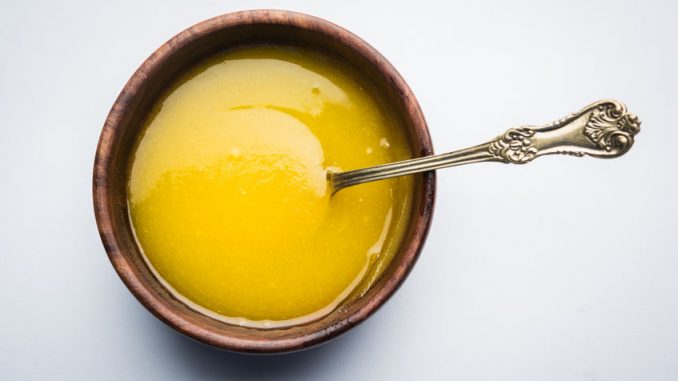
Butter oil and ghee are anhydrous forms of milk fat. Ghee is sometimes referred to as clarified butter. These have to defined as products that come exclusively from milk, cream and butter supplied by various animals.
Butter oil is often described as milk fat, anhydrous milk fat, dry butter fat and dehydrated butter fat.
Butter oil is often used in ice-cream manufacture.
The moisture content has a maximum value of 0.3% which is extremely low because of the way it is made.
Ghee and butter oil are prepared by melting butter in the temperature ranges of 50 to 80, or 110 to 140 ºC respectively.
The heating generates particularly unique flavours because of the method by which water is driven off.
Both products are prone to chemical deterioration because of lipid oxidation.
Butter Oil Flavour
The volatile compounds in butter oil have received plenty of attention over the years. Forss et al., (1967) identified various compounds such as butanone, undecan-2-one, 5-dodecalactone, diacetyl, n-nonanoic acid, a decenoic acid, methyl n-decanoate, toluene, o-methoxyphenol, a cresol, phenol, benzaldehyde, methyl benzoate and benzothiazole.
Aroma extract dilution analysis has been used to identify 19 odour volatiles in butter oil. The following compounds were identified:
diacetyl, acetic and butyric acid, 1-hexen-3-one, (Z)-3-hexenal, 1-octen-3-one, (Z)-1,5-octadien-3-one, guaiacol, (Z)- and (E)-2-nonenal, (E,E)-2,4-decadienal, skatole, vanillin, (Z)-6-dodecen-γ-lactone,δ-octalactone andδ-decalactone.
During storage of butter oil at room temperature, the concentrations of 1-octen-3-one, (E)-2-nonenal and (Z)-1,5-octa-dien-3-one increase. These are the compounds most associated with lipid peroxidation.
Manufacturing Process Of Ghee
Various methods are used to prepare ghee/butter oil:
(1) Westfalia process: The cream with 40% of fat is placed in a cream concentrator to remove the nonfat-milk solids portion. This increases the fat content to 75% in the cream. The product is homogenized to destroy the membrane structure around the fat globules. The fat is separated from the solids and the water or aqueous phase in the centrifuge.
The semi-dry oil is washed with water, centrifuged again and then vacuum dried. It is cooled to 20°C and then packaged.
(2) Alfa-Laval process: Cream with a 30 to 40% fat content is warmed to between 55 and 58 °C and then passed through an hermetic separator which is a type of pre-concentrator. This concentrates the cream to a fat level of 70 to 75%. The high-fat cream is passed to a centrifixator which is often used for cream homogenization. This is a paring chamber for phase inversion into a water-in-oil emulsion.
The next concentrator separates out the milk fat which is washed, reseparated and then passed into a vacuum chamber at 80–90°C for removing residual moisture.
The oil is then cooled to between 20–26°C.
(3) White butter as feedstock: The butter is melted into a pumpable form at about 50 C. This is passed through a plate heat exchanger raising the temperature to 70–80°C and then held in a sealed tank for a few minutes to break the emulsion.
The pump is separated and the butter serum removed. the butterfat is washed with hot water and subsequently reseparated.
the fat is passed through to a vacuum chamber for the removal; of the residual moisture.
Cooling and storage is needed.
References
Forss, D. A., Stark, W., & Urbach, G. (1967). Volatile compounds in butter oil: I. Lower boiling compounds. Journal of Dairy Research, 34(2), pp. 131-137 (Article).
Stark, W., Urbach, G., Hamilton, J. S., & Forss, D. A. (1973). Volatile compounds in butter oil: III. Recovery of added fatty acids and δ-lactones From volatile-free butter oil by cold-finger molecular distillation. Journal of Dairy Research, 40(1), pp. 39-46.
Widder, S., Sen, A. & Grosch, W. (1991) Changes in the flavour of butter oil during storage. Z Lebensm Unters Forch 193, pp. 32–35 (Article)
Leave a Reply